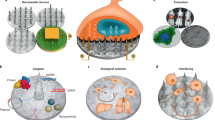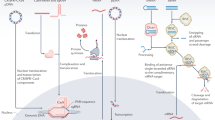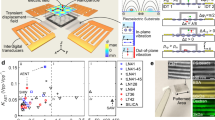Abstract
Precise delivery of molecular doses of biologically active chemicals to a pre-specified single cell among many, or a specific subcellular location, is still a largely unmet challenge hampering our understanding of cell biology. Overcoming this could allow unprecedented levels of cell manipulation and targeted intervention. Here, we show that gold nanowires conjugated with a cytokine such as tumour-necrosis factor-alpha can be transported along any prescribed trajectory or orientation using electrophoretic and dielectrophoretic forces to a specific location with subcellular resolution. The nanowire, 6 µm long and 300 nm in diameter, delivered the cytokine and activated canonical nuclear factor-kappaB signalling in a single cell. Combined computational modelling and experimentation indicated that cell stimulation was highly localized to the nanowire vicinity. This targeted delivery method has profound implications for controlling signalling events on the single cell level.
This is a preview of subscription content, access via your institution
Access options
Subscribe to this journal
Receive 12 print issues and online access
$259.00 per year
only $21.58 per issue
Buy this article
- Purchase on Springer Link
- Instant access to full article PDF
Prices may be subject to local taxes which are calculated during checkout





Similar content being viewed by others
References
Bray, S. J. Notch signalling: a simple pathway becomes complex. Nature Rev. Mol. Cell. Biol. 7, 678–689 (2006).
Delves, P. J. & Roitt, I. M. The immune system. First of two parts. N. Engl. J. Med. 343, 37–49 (2000).
Nagata, S. Fas ligand-induced apoptosis. Annu. Rev. Genet. 33, 29–55 (1999).
Wu, Y. I. et al. A genetically encoded photoactivatable Rac controls the motility of living cells. Nature 461, 104–108 (2009).
Lee, H. M., Larson, D. R. & Lawrence, D. S. Illuminating the chemistry of life: design, synthesis and applications of ‘caged' and related photoresponsive compounds. ACS Chem. Biol. 4, 409–427 (2009).
Mayer, G. & Heckel, A. Biologically active molecules with a ‘light switch’. Angew. Chem. Int. Ed. Engl. 45, 4900–4921 (2006).
Takayama, S. et al. Patterning cells and their environments using multiple laminar fluid flows in capillary networks. Proc. Natl Acad. Sci. USA 96, 5545–5548 (1999).
Takayama, S. et al. Selective chemical treatment of cellular microdomains using multiple laminar streams. Chem. Biol. 10, 123–130 (2003).
Takayama, S. et al. Subcellular positioning of small molecules. Nature 411, 1016 (2001).
Fan, D. L., Cammarata, R. C. & Chien, C. L. Precision transport and assembling of nanowires in suspension by electric fields. Appl. Phys. Lett. 92, 093115 (2008).
Fan, D. L., Zhu, F. Q., Cammarata, R. C. & Chien, C. L. Controllable high-speed rotation of nanowires. Phys. Rev. Lett. 94, 247208 (2005).
Fan, D. L., Zhu, F. Q., Cammarata, R. C. & Chien, C. L. Efficiency of assembling of nanowires in suspension by ac electric fields. Appl. Phys. Lett. 89, 223115 (2006).
Fan, D. L., Zhu, F. Q., Cammarata, R. C. & Chien, C. L. Manipulation of nanowires in suspension by AC electric fields. Appl. Phys. Lett. 85, 4175–4177 (2004).
Cheong, R. et al. Transient IκB kinase activity mediates temporal NF-κB dynamics in response to a wide range of tumor necrosis factor-α doses. J. Biol. Chem. 281, 2945–2950 (2006).
Whitney, T. M., Searson, P. C., Jiang, J. S. & Chien, C. L. Fabrication and magnetic properties of arrays of metallic nanowires. Science 261, 1316–1319 (1993).
Huber, D. L., Manginell, R. P., Samara, M. A., Kim, B. I. & Bunker, B. C. Programmed adsorption and release of proteins in a microfluidic device. Science 301, 352–354 (2003).
Aggarwal, B. B. et al. Human tumor necrosis factor. Production, purification and characterization. J. Biol. Chem. 260, 2345–2354 (1985).
White, B., Banerjee, S., O'Brien, S., Turro, N. J. & Herman, I. P. Zeta-potential measurements of surfactant-wrapped individual single-walled carbon nanotubes. J. Phys. Chem. C 111, 13684–13690 (2007).
Yin, Z., Noren, D., Wang, C. J., Hang, R. & Levchenko, A. Analysis of pairwise cell interactions using an integrated dielectrophoretic–microfluidic system. Mol. Syst. Biol. 4, 232 (2008).
Wajant, H., Pfizenmaier, K. & Scheurich, P. Tumor necrosis factor signaling. Cell Death Differ. 10, 45–65 (2003).
Hoffmann, A., Levchenko, A., Scott, M. L. & Baltimore, D. The IκB-NF-κB signaling module: temporal control and selective gene activation. Science 298, 1241–1245 (2002).
Cheong, R., Hoffmann, A. & Levchenko, A. Understanding NF-κB signaling via mathematical modeling. Mol. Syst. Biol. 4, 192 (2008).
Schwarz, J. A. & Contescu, C. I. Surfaces of Nanoparticles and Porous Materials xvi, p. 787 (Marcel Dekker, 1999).
Mato, J. M., Losada, A., Nanjundiah, V. & Konijn, T. M. Signal input for a chemotactic response in the cellular slime mold Dictyostelium discoideum. Proc. Natl Acad. Sci. USA 72, 4991–4993 (1975).
Kim, D. H. et al. Mechanosensitivity of fibroblast cell shape and movement to anisotropic substratum topography gradients. Biomaterials 30, 5433–5444 (2009).
Van Haastert, P. J. & Devreotes, P. N. Chemotaxis: signalling the way forward. Nature Rev. Mol. Cell. Biol. 5, 626–634 (2004).
Black, R. A. et al. A metalloproteinase disintegrin that releases tumour-necrosis factor-α from cells. Nature 385, 729–733 (1997).
Cai, D. et al. Highly efficient molecular delivery into mammalian cells using carbon nanotube spearing. Nature Methods 2, 449–454 (2005).
Kim, W., Ng, J. K., Kunitake, M. E., Conklin, B. R. & Yang, P. Interfacing silicon nanowires with mammalian cells. J. Am. Chem. Soc. 129, 7228–7229 (2007).
Zoski, C. G. Handbook of Electochemistry (Elsevier, 2007).
Kearns, J. D., Basak, S., Werner, S. L., Huang, C. S. & Hoffmann, A. IκBɛ provides negative feedback to control NF-κB oscillations, signaling dynamics and inflammatory gene expression. J. Cell. Biol. 173, 659–664 (2006).
Werner, S. L., Barken, D. & Hoffmann, A. Stimulus specificity of gene expression programs determined by temporal control of IKK activity. Science 309, 1857–1861 (2005).
Acknowledgements
The authors thank W. Greene of UCSF for providing the p65 plasmid, J. Wang for helping with cell transfection, X. Li for TNFα labelling and Z. Wang for microplate scanning. D.F., F.Q.Z., C.L.C. acknowledge support from the National Science Foundation (DMR 0403849). R.C.C. acknowledges support from the National Science Foundation (DMR 0706178). Z.Y., R.C. and A.L. acknowledge the support from the National Institutes of Health (GM072024, RR020839). D.F. acknowledges start up support from University of Texas at Austin. R.C. acknowledges support from the Medical Scientist Training Program at Johns Hopkins University.
Author information
Authors and Affiliations
Contributions
D.F., Z.Y., C.L.C. and A.L. conceived and designed the experiments and analysis. Z.Y., D.F. and F.Q.Z. performed the experiments and analysed the data. R.C. performed the simulations. All authors discussed the results and co-wrote the paper.
Corresponding authors
Ethics declarations
Competing interests
The authors declare no competing financial interests.
Supplementary information
Supplementary information
Supplementary information (PDF 631 kb)
Supplementary information
Supplementary movie 1 (AVI 1452 kb)
Supplementary information
Supplementary movie 2 (AVI 781 kb)
Supplementary information
Supplementary movie 3 (AVI 643 kb)
Supplementary information
Supplementary movie 4 (AVI 2468 kb)
Supplementary information
Supplementary movie 5 (AVI 4327 kb)
Supplementary information
Supplementary movie 6 (AVI 1444 kb)
Rights and permissions
About this article
Cite this article
Fan, D., Yin, Z., Cheong, R. et al. Subcellular-resolution delivery of a cytokine through precisely manipulated nanowires. Nature Nanotech 5, 545–551 (2010). https://doi.org/10.1038/nnano.2010.104
Received:
Accepted:
Published:
Issue Date:
DOI: https://doi.org/10.1038/nnano.2010.104
This article is cited by
-
Precise electrokinetic position and three-dimensional orientation control of a nanowire bioprobe in solution
Nature Nanotechnology (2023)
-
Light programmable micro/nanomotors with optically tunable in-phase electric polarization
Nature Communications (2019)
-
Development of micro- and nanorobotics: A review
Science China Technological Sciences (2019)
-
Recent progress on the design and fabrication of micromotors and their biomedical applications
Bio-Design and Manufacturing (2018)
-
Real-time motion planning of multiple nanowires in fluid suspension under electric-field actuation
International Journal of Intelligent Robotics and Applications (2018)



